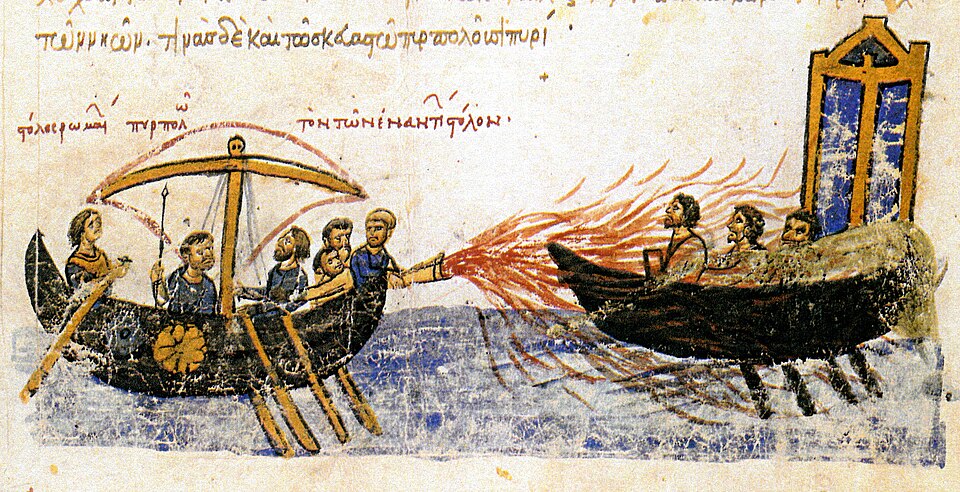
What is Greek fire? It was a burning material that was invented as a weapon by the Byzantine Empire in the 7th century.
We call it Greek fire, in English, but it was not really Greek. The Byzantine Empire was created when the Roman Empire split into Western and Eastern halves. The eastern half became the Byzantine Empire, so their weapon was technically Roman fire, or Byzantine fire. Although that being said, Greek was the official language of the Byzantine Empire from the 7th century, and most of their territory centered around the “Greek” part of the world. The Byzantine Emperor was sometimes called the Emperor of the Greeks, as a derogatory name. The English name for the fire weapon came about when European crusaders saw it in the crusades, and they considered the Byzantines to be Greek, which is why it is called “Greek” fire. The Byzantines called it liquid fire or sea fire.
Greek fire was a liquid that could be fired from boats into the sea. It was launched through a tube and could apparently travel a significant distance into the sea. The substance burned and stayed alight even when on the sea. The only way to put it out was with sand, vinegar, or other such substances. Some reports say it was on fire when it was launched, and some reports say it started burning when it hit the sea. Boats could also launch it onto ships that came too close, and they even had hand grenades that were filled with the same substance.
The fire was very effective, and it made the Byzantine navy more powerful. The Byzantine Empire was at a low point at the time. Muslim Arabs were slowly pushing the Byzantine Empire back and competing for land, and this new weapon could turn the tide in the battles. It also had motivational value because it looked like fire from God. Greek fire was instrumental in several major victories over the Arabs, and it helped the Byzantine Empire come through its slump and carry on for another thousand years. Fire is terrifying, and the weapon had a great psychological impact. Enemy ships would often run at the sight of it. If you tried to put it out with water, it would just spread. And if people jumped off their burning ship into the sea, they would get covered in it and burn as well. A pretty nasty way to go. Enemy ships learned to stay out of range of it, which limited their ability to fight. Enemy ships worked out that vinegar extinguished the fire, and they kept vinegar-soaked hides on board, but it is difficult to put out fire when your whole ship is burning. There was one disadvantage that the sea needed to be fairly calm and the wind low, or the substance could be blown back into the Byzantine ships.
Greek fire was first used in 672 AD, and it is said to have been invented by a Byzantine architect called Callinicus of Heliopolis. He was fleeing the expanding empire of Muslim Arabs. Callinicus is said to have shown the Emperor Constantine IV his Greek fire, and Constantine quickly ordered it to be used in battles with the Arabs.
It is probably unlikely that a single person was the inventor of the fire, and it probably came about over years of experimentation. Whoever was responsible, the recipe for the fire was a very carefully kept secret. In fact, it was so carefully kept that it was not written down, and today there is no way of knowing what it was made of. The only thing historians and chemists can do is look at the accounts of the weapon and try to reverse engineer it.
The things that are known about Greek fire are that it burned on water. Some people said it was ignited by water. It was a liquid. It could be ejected out of a pipe. There was a lot of smoke and the sound of thunder. Experts think that it was probably a mixture of crude oil, pine resin, sulphur, quicklime, animal fat, and some other things. There were several natural oil wells throughout the Byzantine Empire, which gave them access to the crude oil. They also knew how to make quicklime, which reacts explosively with water. They could also have added calcium phosphate, which is made by boiling bones in urine. This releases phosphine on contact with water, which would ignite. They may have used a mixture of all of these chemicals. Then, once they started burning, the oil would provide the energy to keep the fire going, and oil is hydrophobic, so it would burn on water. The resins and other materials would make it very sticky. It was a very fearsome weapon. And this is what I learned today.
Sources
https://medieval.substack.com/p/a-brief-history-of-greek-fire
https://en.wikipedia.org/wiki/Greek_fire
https://en.wikipedia.org/wiki/Early_Muslim_conquests
https://www.britannica.com/technology/Greek-fire
https://www.rmg.co.uk/stories/maritime-history/greek-fire
https://en.wikipedia.org/wiki/Callinicus_of_Heliopolis
https://pubs.acs.org/doi/abs/10.1021/ed014p360
https://www.asmalldoseoftoxicology.org/greekfire
https://stronghold.heavengames.com/sc/history/greekfire
Image By Unknown author – Codex Skylitzes Matritensis, Bibliteca Nacional de Madrid, Vitr. 26-2, Bild-Nr. 77, f 34 v. b. (taken from Pászthory, p. 31), Public Domain, https://commons.wikimedia.org/w/index.php?curid=302463
